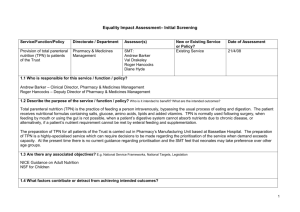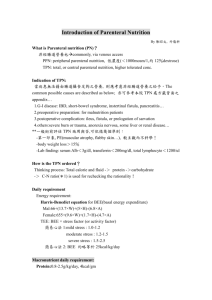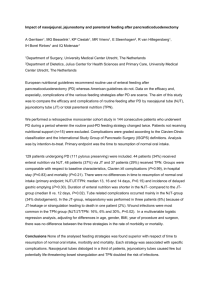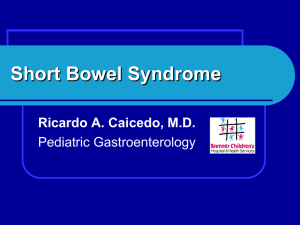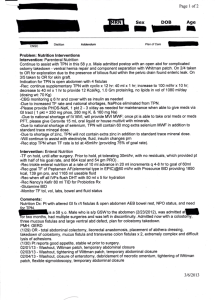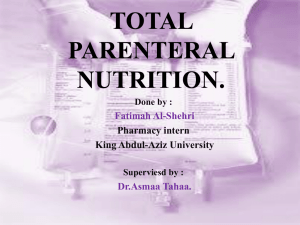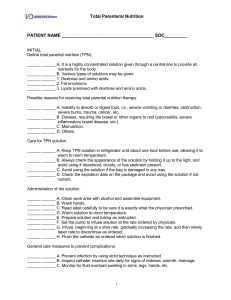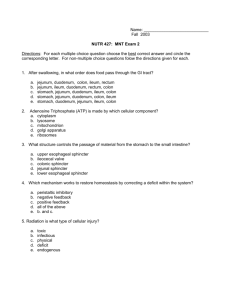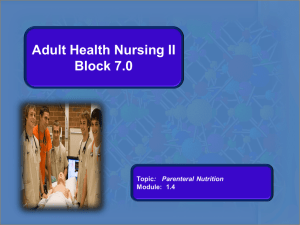TPN (Total Parenteral Nutrition)
advertisement
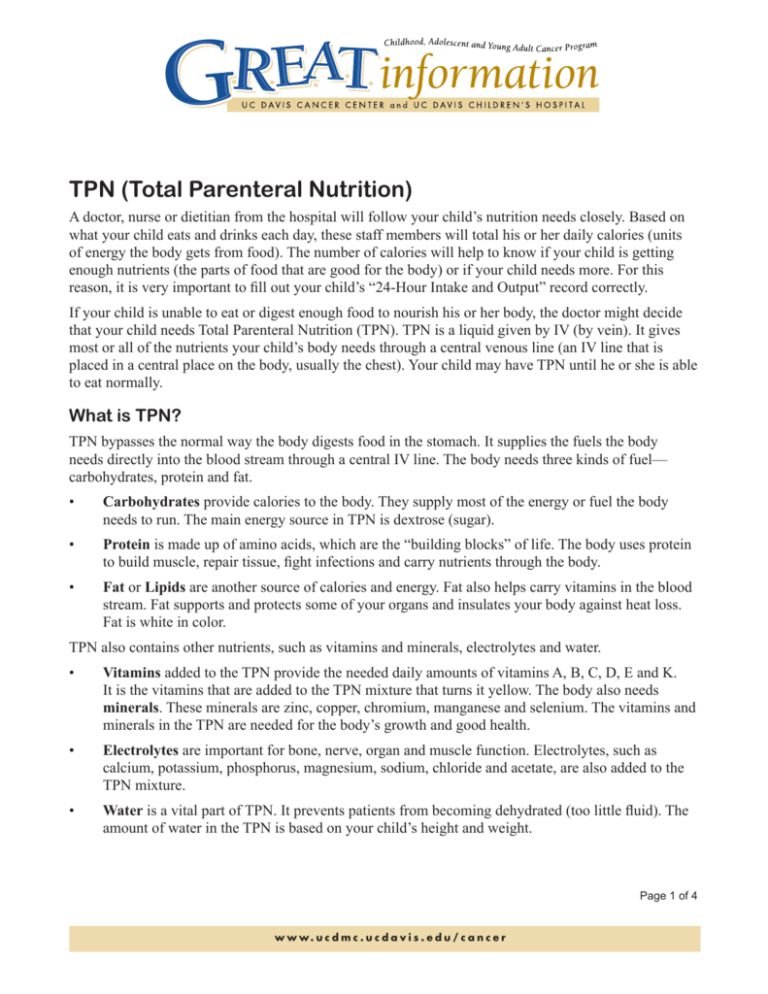
TPN (Total Parenteral Nutrition) A doctor, nurse or dietitian from the hospital will follow your child’s nutrition needs closely. Based on what your child eats and drinks each day, these staff members will total his or her daily calories (units of energy the body gets from food). The number of calories will help to know if your child is getting enough nutrients (the parts of food that are good for the body) or if your child needs more. For this reason, it is very important to fill out your child’s “24-Hour Intake and Output” record correctly. If your child is unable to eat or digest enough food to nourish his or her body, the doctor might decide that your child needs Total Parenteral Nutrition (TPN). TPN is a liquid given by IV (by vein). It gives most or all of the nutrients your child’s body needs through a central venous line (an IV line that is placed in a central place on the body, usually the chest). Your child may have TPN until he or she is able to eat normally. What is TPN? TPN bypasses the normal way the body digests food in the stomach. It supplies the fuels the body needs directly into the blood stream through a central IV line. The body needs three kinds of fuel— carbohydrates, protein and fat. • Carbohydrates provide calories to the body. They supply most of the energy or fuel the body needs to run. The main energy source in TPN is dextrose (sugar). • Protein is made up of amino acids, which are the “building blocks” of life. The body uses protein to build muscle, repair tissue, fight infections and carry nutrients through the body. • Fat or Lipids are another source of calories and energy. Fat also helps carry vitamins in the blood stream. Fat supports and protects some of your organs and insulates your body against heat loss. Fat is white in color. TPN also contains other nutrients, such as vitamins and minerals, electrolytes and water. • Vitamins added to the TPN provide the needed daily amounts of vitamins A, B, C, D, E and K. It is the vitamins that are added to the TPN mixture that turns it yellow. The body also needs minerals. These minerals are zinc, copper, chromium, manganese and selenium. The vitamins and minerals in the TPN are needed for the body’s growth and good health. • Electrolytes are important for bone, nerve, organ and muscle function. Electrolytes, such as calcium, potassium, phosphorus, magnesium, sodium, chloride and acetate, are also added to the TPN mixture. • Water is a vital part of TPN. It prevents patients from becoming dehydrated (too little fluid). The amount of water in the TPN is based on your child’s height and weight. Page 1 of 4 w w w. u c d m c . u c d a v i s . e d u / c a n c e r Continued Staff members will use blood tests to check the balance of all the TPN parts. The most critical of these tests is the chemistry test that your child will have during each clinic visit. The TPN mixture may be changed, based on your child’s needs and the blood test results. Possible TPN-related problems Some problems might occur when your child is on TPN. Sometimes the problem can be fixed by changing the levels of protein, carbohydrates or electrolytes in the TPN mixture. The doctor, nurse or dietitian will review all of your child’s blood tests and will correct any imbalances. Hyperglycemia, or too much blood sugar, is one of the problems that can occur while your child is receiving TPN. This imbalance does not happen often, but you should be aware of it. Hyperglycemia (High blood sugar) Hyperglycemia is a higher than normal level of sugar in the blood. • It can happen when TPN is given too fast or if the body cannot accept the sugar. Sometimes having an infection or taking a medicine such as a steroid will make the body unable to use large amounts of sugar. • Your child may have a headache or feel thirsty, weak or sick to his or her stomach. • Your child’s blood tests will be monitored closely. One of those tests checks the sugar level in the blood. Beginning inpatient TPN If the doctor decides that your child needs TPN, it will start in the hospital. TPN is started as a nonstop infusion over a 24-hour period. A dietitian along with your child’s doctor will decide the total number of calories and other nutrients your child needs each day. The staff wants to avoid causing high blood sugar (hyperglycemia) when starting TPN. To do this, the sugar (dextrose) in the TPN is slowly increased each day over several days until your child’s total calorie need is met. During your child’s hospital stay, please write down everything your child eats or drinks for each 24hour period on the “Intake and Output” record. The dietitian uses this information to calculate how many calories your child is taking in my mouth. This will help the clinical team know how many calories need to go into the TPN mixture. Your child must be weighed every morning at about the same time. This daily weight tells the clinical team if your child is getting enough fluid or too much fluid in his or her TPN. If your child is an inpatient on TPN, the staff will draw blood early each morning for tests so the results will be ready for morning rounds by the clinical team. The blood test results will help the doctor know how your child’s body is doing on the TPN. Page 2 of 4 w w w. u c d m c . u c d a v i s . e d u / c a n c e r Continued Starting the discharge process Preparing to go home as an outpatient with TPN If your child is on TPN in the hospital and he or she cannot eat or drink without vomiting, TPN may be continued at home. Your child’s doctor and clinical team will look at several factors before discharging your child on home TPN: • Can the child take food or liquids by mouth without vomiting? • Does the child have a parent or main caregiver who is able and willing to give home TPN? • Do the caregivers want to learn the process of home TPN? • Will the child be able to get medical care in his or her local area if there are problems with the TPN? The parent and other caregivers must learn how to give outpatient TPN correctly and safely. Before you and your child are discharged, you will learn the following: • The best way to clean your hands • How to run the ambulatory infusion pump (the machine used for giving TPN) • How to connect and disconnect your child from the TPN • Possible problems and how to correct them • Who to call if you have TPN problems or concerns. IV infusion company The staff will make plans with an IV infusion company to help your child receive quality care while he or she is an outpatient. Which IV infusion company the staff members choose is based on your insurance company’s IV infusion preferred provider. The staff members will also choose a company that they feel will help deliver the best care for your child. If you have a provider that you want to use and they are covered under your insurance, please tell the nurse or discharge planner. The IV infusion company will deliver everything you need to give home TPN, including the pump, IV pole, backpack and supplies. They will be delivered to the place where you are staying or at your home. A company staff member will also give you a telephone number that you can call 24-hours-a-day if you have problems with the pump or have questions or concerns. The supplies that the infusion company gives you for home TPN cannot be returned even when they are unused. The following are some of the supplies that the IV infusion company will provide: • TPN mixture • Multivitamins Page 3 of 4 w w w. u c d m c . u c d a v i s . e d u / c a n c e r Continued • Alcohol pads • IV medicines (if ordered by the doctor) • Heparin and normal saline • Tubing • Batteries Two types of TPN plans – continuous and cycled While your child is in the hospital, the TPN runs continuously (all the time). When your child is about to be discharged as an outpatient, the TPN can run over shorter time periods, such as 12, 14, 16 or 20 hours. Each time period is called a “cycle.” Usually, the cycle is started in the evening so that the TPN can be given while the child is sleeping. By doing this, your child’s cycle will end sometime during the day. This will allow your child to be flushed and clamped part of the day while he or she is still awake. Each patient has a cycle goal that is set by a dietitian. The length of the cycle is based on your child’s size and needs. When your child is on continuous TPN, the dietitian will slowly reduce the number of hours that the TPN runs each night until the best “cycle” time for your child is reached. Sometimes your child’s TPN still must run continuously over 24 hours. Your child’s doctor or dietitian will decide if this is needed. The nurse or the infusion company nurse will teach you how to give your child’s type of TPN, whether it is “continuous” or “cycled.” If you have more questions about TPN, please talk to your child’s doctor, nurse or dietitian. Adapted with permission from St. Jude Children’s Research Hospital. Revised 1/04 UC Davis Cancer Center 12/06 w w w. u c d m c . u c d a v i s . e d u / c a n c e r Page 4 of 4
